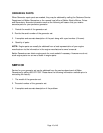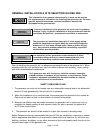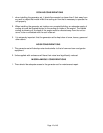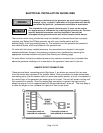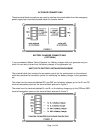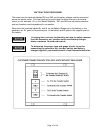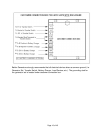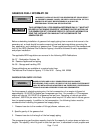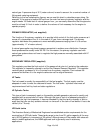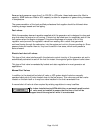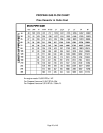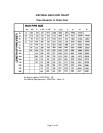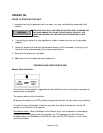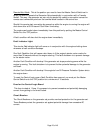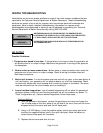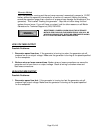Page 18 of 45
natural gas. A pressure drop of 0.3' (water column) is used to account for a nominal number of
fittings and metering equipment.
Referring to the fuel consumption figures, we can use this chart to calculate proper sizing. For
example, if the engine is located 30 feet from the main fuel source's primary regulator and the
engine needs 100 cubic feet of natural gas per hour, you can easily determine that the pipe size
must be at least 3/4 inch in order to deliver the volume of fuel necessary for the engine to
operate properly.
PRIMARY REGULATOR (not supplied)
The function of the primary regulator is to provide initial control of the fuel under pressure as it
comes off a transmission line, or in the case of LP gas, from a storage tank. The primary
regulator distributes line pressures to more workable pressures ranging from 4 to 6 ounces
(approximately 11" of water column).
A natural gas supplier may boost pressure somewhat to achieve even distribution. However
these pressures are usually under 50 PSI. For this reason, the primary regulator used with
natural gas systems does not have to regulate the high pressures normally associated with LP
gas systems.
SECONDARY REGULATOR (supplied)
This regulator provides the final control of the gaseous fuel prior to it entering the carburetor.
This regulator is frequently referred to as the Low Pressure Demand Regulator. This regulator
receives gas at a pressure of 4 to 6 ounces from the primary regulator, then reduces the
pressure and delivers it to the engine's carburetor as the engine demands.
LP Tanks
The fuel vessel is usually the responsibility of the fuel supplier. The fuel supply must be
adequate in order to meet the customer's needs. The fuel tanks / cylinders must meet all
requirements set forth by local and state regulations.
LP Cylinder Tanks
This type of tank is commonly used on the smaller portable generator sets and is usually only
equipped with a manual shut-off valve. Although this type of tank is of adequate strength to
withstand the high fuel pressures, it has one drawback in that the tank is normally of such a
small size that you can only achieve minimal run times off of the tank of fuel before it has to be
refilled (4 to 7 hours).
LPG bulk tanks
The American Society of Mechanical Engineers has established certain requirements for the
construction of LPG bulk tanks. These tanks range in size from 20- gallon capacity all the way
up to 90,000 gallons in increments of 20 gallons. Although some of the smaller tank sizes are
used in mobile applications, the ASME approved tank is generally used in stationary
applications.



